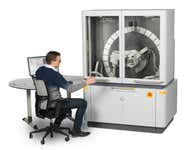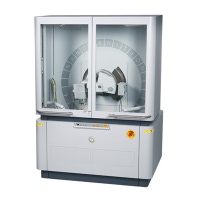
Empyrean range
Multipurpose X-ray diffractometers for your analytical needs
Nanostructure analysis of thin films and on surfaces
Grazing incidence small angle X-ray scattering (GISAXS) is applied to thin surface layers containing nanoparticles, pores and other nonhomogeneities with dimensions in the range 1 – 100 nm. GISAXS is used to obtain information about the size, shape and alignment of these nanoscale features. Whereas SAXS (small-angle X-ray scattering) is applied to nanomaterials in liquid or powder form, GISAXS is applied to surface layers on flat substrates. GISAXS is used to reveal lateral dimensions and arrangements.
Thin film nanomaterials are an active research area in energy technologies, photovoltaic materials, semiconductor devices, photonics, acoustics and catalysis, to name a few. Since the early 1990s there has been a rapid increase in synthesis methods of nanostructured thin films. Thin film synthesis can be combined with lithographic methods, often to enhance ordering in nanostructures.
Integrated circuits:
Porous silica films are often used in integrated circuits in which the degree of porosity is used to control the dielectric properities of capacitors. These nanoporous materials can be synthesized using amphiphilic block copolymers in a sol gel process. Using structural directing agents, highly ordered nanoporous arrays can be created.
Magnetic memory devices:
By a number of different processing routes, metal and metal oxide nanoparticle arrays are synthesized for electronic and magnetic applications.
Optoelectronics and LEDS:
Advanced molecular beam epitaxy (MBE) and chemical vapour deposition (CVD) methods are used to produce semiconducting quantum dots and nanowires for optoelectronic applications.
Catalysis:
Thin films and monolayers of precious metal nanoparticles can be synthesized using solution phase methods and are used in catalysis.
Batteries and gas storage systems:
Nano-porosity is exploited for the storage of gases.
Quality control:
Whilst reflectometry can provide detailed depth information on the quality of interfaces, GISAXS is used to reveal lateral dimensions including interfacial steps and irregularities.


Multipurpose X-ray diffractometers for your analytical needs
GISAXS experiments can be performed on the Empyrean multipurpose diffractometer. Full instructions for the deployment of the GISAXS configuration, GISAXS alignment and measurement are provided in the Empyrean user guide documentation.
For an experiment employing Cu Kα radiation, GISAXS data are collected at low angles, for example in the range 0-3o. This range is ideally suited to 2D imaging using the 55μm pitch PIXcel3D detector. 2D GISAXS measurements can be performed using the PIXcel3D and the PIXcel3D 2X2 detectors. An extremely low detector background allows for long counting times, enabling the observation of weak scattering.

Empyrean Nano EditionVersatile X-ray scattering platform |

EmpyreanThe intelligent diffractometer |
|
|---|---|---|
| Technology | ||
| X-ray Diffraction (XRD) | ||